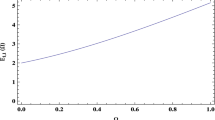Abstract
A relativistic phase-space representation for a class of observables with matrix-valued Weyl symbols proportional to the identity matrix (charge-invariant observables) is proposed. We take into account the nontrivial charge structure of the position and momentum operators. The evolution equation coincides with its analog in relativistic quantum mechanics with nonlocal Hamiltonian under conditions where particle-pair creation does not take place (free particle and constant magnetic field). The differences in the equations are connected with the peculiarities of the constraints on the initial conditions. An effective increase in coherence between eigenstates of the Hamiltonian is found and possibilities of its experimental observation are discussed.
Similar content being viewed by others
References
B. I. Lev, A. A. Semenov, and C. V. Usenko, J. Phys. A: Math. Gen., 34, 4323 (2001).
H. Feshbach and F. Villars, Rev. Modern. Phys., 30, 24 (1958).
S. P. Gavrilov and D. M. Gitman, Int. J. Mod. Phys. A, 15 4499 (2000); Class. Quantum Gravit., 17, L133 (2000); 18, 2989 (2001).
T. D. Newton and E. P. Wigner, Rev. Mod. Phus., 21, 400 (1949).
L. L. Foldy and S. A. Wouthuysen, Phys. Rev. A, 78, 29 (1950).
Z. K. Silagadze, “The Newton-Wigner position operator and the domain of validity of one-particle relativistic theory,” Preprint SLAC-PUB-5754 Rev (1993).
S. R. de Groot, W. A. van Leeuwen, and Ch. G. van Weert, Relativistic Kinetic Theory. Principles and Applications, North-Holland, Amsterdam (1980).
A. A. Rukhadze and V. P. Silin, Zh. Éksp. Teor. Fiz., 38, 645 (1960).
S. R. de Groot and L. G. Suttorp, Fundations of Electrodynamics, North-Holland, Amsterdam (1972).
Y. S. Kim and E. P. Wigner, Phys. Rev. A, 38, 1159 (1988); 39, 2829 (1989).
Chang-Ho Kim and Y. S. Kim, J. Math. Phys., 32, 1998 ((1991).
S. Tomonaga, Prog. Theor. Phys., 1, 27 (1946). J. Schwinger, Phys. Rev., 74, 1439 (1948).
A. Suarez and V. Scarani, Phys. Lett. A, 232, 9 (1997). H. Zbinden, J. Brendel, W. Tittel, and N. Gisin, J. Phys. A: Math. Gen., 34, 7103 (2001); Phys. Rev. A, 63, 02211 (2001). A. Stefanov, H. Zbingen and N. Gisin, “Quantum correlations versus multisimultaneity: an experiment test,” Preprint quant-ph/0110117 (2002). S. Hacyan, Phys. Lett. A, 288, 59 (2001).
A. J. Bracken and G. F. Melloy, J. Phys. A: Math. Gen., 32, 6127 (1999).
B. I. Lev, A. A. Semenov, and C. V. Usenko, Phys. Lett. A, 230, 261 (1997).
H.-J. Briegel, B.-G. Englert, M. Michaelis, and G. Süssmann, Z. Naturforsch., 46a, 925 (1991). H.-J. Briegel, B.-G. Englert, and G. Süssmann, Z. Naturforsch., 46a, 933 (1991).
M. S. Bartlett and J. E. Moyal, Proc. Cambridge Philos. Soc., 45, 545 (1949).
T. Curtright, T. Uematsu, and C. Zachos, J. Math. Phys., 42, 2396 (2001).
D. Fairlie, Proc. Cambridge Philos. Soc., 60, 581 (1964).
E. P. Wigner, Z. Phys., 133, 101 (1952). G. C. Wick, A. S. Wightman, and E. P. Wigner, Phys. Rev., 88, 101 (1952).
A. A. Grib, S. G. Mamaev, and V. M. Mostepanenko, Vacuum Quantum Effects in Strong Fields [in Russian], Energoatomizdat, Moscow (1988).
V. I. Tatarskii, Sov. Phys.-Uspekhi, 26, 311 (1983).
E. Joos and H. D. Zeh, Z. Phys. B, 59, 223 (1984). E. Joos, Phys. Rev. D, 29, 1626 (1984). W. H. Zurek, Phys. Rev. D, 24, 1516 1981); 26, 1862 (1982); Nature, 412, 712 (2001). L. Stodolsky, Phys. Lett. B, 116, 464 (1982). M. V. Menskii, Phys.-Uspekhi, 43, 585 (2000). S. A. Kilin, Phys.-Uspekhi, 42, 435 (1999).
G. M. D'Ariano, S. Mancini, V. I. Man'ko, and P. Tombesi, J. Opt. B: Quantum Semiclass. Opt., 8, 1017 (1996). S. Mancini, V. I. Man'ko, and P. Tombesi, J. Mod. Opt., 44, 2281 (1997).
V. V. Dodonov and S. S. Mizrahi, Phys. Lett. A, 117, 394 (1993).
M. N. Johnson and B. A. Lippmann, Phys. Rev., 76 828 (1949).
H. Bateman and A. Erdélyi, Higher Transcendental Functions, McGraw-Hill, New York (1953).
Author information
Authors and Affiliations
Rights and permissions
About this article
Cite this article
Lev, B.I., Semenov, A.A. & Usenko, C.V. Scalar Charged Particle in Weyl–Wigner–Moyal Phase Space. Constant Magnetic Field. Journal of Russian Laser Research 23, 347–368 (2002). https://doi.org/10.1023/A:1016342310852
Issue Date:
DOI: https://doi.org/10.1023/A:1016342310852



